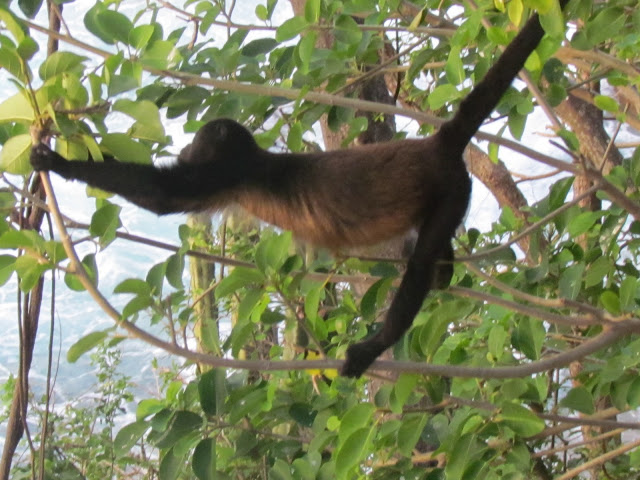There are many howler monkeys around our beach house. Some days they drop by and we can watch them from the decks. They are considered the largest of the new world monkeys.
Howler monkeys have a short snout, and wide-set, round nostrils. They range in size from 56 to 92 cm, excluding their tail which can be equally as long. Like many New World monkeys, they have prehensile tails. Unlike other New World monkeys, both male and female howler monkeys have trichromatic color vision.This has evolved independently from other New World monkeys due to gene duplication. They have a lifespan of 15 to 20 years. Howler species are dimorphic and can also be dichromatic (i.e. Alouatta araya). Males are, on average, 1.5 to 2 kg heavier than females.
Howler monkeys generally move quadrupedally on the tops of branches, usually grasping a branch with at least two hands or one hand and the tail at all times. They have strong prehensile tails which are able to support the monkey's entire body weight. However, fully adult howler monkeys do not often rely on their tail for full body support whereas juveniles do so more frequently.
As their name suggests, vocal communication forms an important part of their social behavior. Group males generally call at dawn and dusk as well as interspersed times throughout the day. The main vocals consist of loud, deep guttural growls or "howls." Howler monkeys are widely considered to be the loudest land animal. According to Guinness Book of World Records, their vocalizations can be heard clearly for 20 miles (32 km). It is hypothesized that the function of howling relates to intergroup spacing and territory protection, as well as possibly mate-guarding.
These large and slow moving monkeys are the only folivores of the New World monkeys. Howlers eat mainly top canopy leaves, together with fruit, buds, flowers, and nuts. They need to be careful not to eat too much of certain species of mature leaf in one sitting, as some of the leaves they eat contain toxins that can poison the monkey. Howler monkeys are also known to occasionally raid birds nests and chicken coops and consume the eggs.
And we "captured" this little guy early morning having a nap













Lovely photos! I can't imagine taking a swim, looking up and finding a monkey! That is exciting -- but I would probably be scared and screaming!
ReplyDeleteVery Exciting! Do you get used to the calling to each other?
ReplyDelete